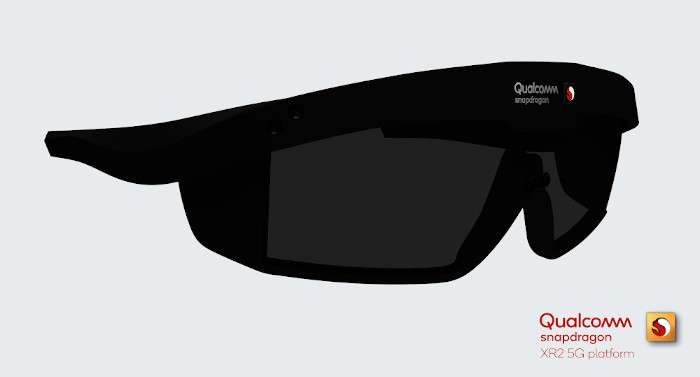
Qualcomm Challenges Intel With New Chips, Unveils New XR Platform
Qualcomm is trying to challenge Intel's dominance of the laptop market with a new set of chips designed for allways-connected computers.
Current models, such as Microsoft’s Surface Pro X, cost more than $1,000. Qualcomm is now rolling out new chips that will allow PC makers to build machines that compete with budget systems retailing for as low as $300.
“We were not confused. We knew this market would take a long time,” said Qualcomm product director Miguel Nunes. “We still understand it’s going to take longer.”
More affordable devices will help, Nunes said. Qualcomm chip-based laptops are now part of the services of mobile phone service providers. Like phones, they’re increasingly being offered on monthly installment purchase plans, making the devices more affordable, Nunes said. Carriers like the cellular component of Qualcomm chips which ties customers to their networks, he said.
Qualcomm is targeting PCs in particular where it believes chips based on mobile technology can offer huge improvements in battery life, promised but not delivered by Intel-based devices, and have them continually connected to the internet.
Qualcomm announced a broad Qualcomm Snapdragon Compute platform portfolio with long battery life, cellular connectivity, and AI accelerated performance to enable fanless, thin and light designs for modern computing.

The Snapdragon 7c and 8c now join the previously announced Snapdragon 8cx, delivering fast cellular connectivity to premium, mainstream, and entry-level notebook PCs. The portfolio is available in various price points. In addition, the Snapdragon 8cx enterprise compute platform brings connected security software and secured-core PC support for modern enterprises.
Qualcomm claims that the Snapdragon 7c compute platform upgrades entry level devices bringing a 25% boost in system performance and up to twice the battery life vs. competing platforms plus lightning- fast connectivity via the Snapdragon X15 LTE modem. The Octa-core Qualcomm Kryo 468 CPU and Qualcomm Adreno 618 GPU deliver responsive performance with long battery life in the entry-tier. In addition, the Qualcomm AI Engine delivers over five trillion operations per second (TOPS) of performance for the latest AI accelerated experiences offered by Windows 10.
The 7nm Snapdragon 8c Compute Platform boosts performance up to 30% over the Snapdragon 850. Purpose-built with the instant-on responsiveness and multi-day battery life of a smartphone, its integrated Snapdragon X24 LTE modem enables multi-gigabit connectivity speeds for cloud computing. Its Qualcomm AI Engine dedicates six TOPS to accelerate machine learning applications, while the GPU provides high-quality graphics, all in an ultra-thin, fan-less design optimized for mainstream use.
Building upon the first 7nm PC platform, the Snapdragon 8cx, the new Snapdragon 8cx Enterprise Compute Platform delivers new capabilities to the workplace.
First 5G XR Platform
Qualcomm also annnounced the Qualcomm Snapdragon XR2 Platform, a 5G-supported extended reality (XR) platform. It unites Qualcomm Technologies’s 5G and AI strengths with the company's XR technology. This platform unveils custom features and boasts multiple firsts that can be scaled across augmented reality (AR), virtual reality (VR) and mixed reality (MR).
The Snapdragon XR2 Platform is packed with performance improvements compared to Qualcomm's current premium-tier XR platform to deliver 2x the CPU and GPU performance, 4x more video bandwidth, 6x higher resolution and 11x AI improvement. The Snapdragon XR2 Platform supports seven concurrent cameras and a dedicated computer vision processor. Additionally, this is the first XR platform to enable low latency camera pass-through to unlock true MR, which allow users to see, interact and create a hybrid of the virtual and real world while wearing a VR device. The platform has customized visuals, interactivity and audio technologies.
In order to experience a heightened sense of realism in XR, it is imperative to close the visual gap between the real and virtual world. This requires cutting-edge display and graphics. Qualcomm says that the Snapdragon XR2 Platform takes a leap in core GPU processing by supporting 1.5x the pixel rate and 3x the texel rate for efficient, high graphics rendering. XR specific features like foveated rendering with eye tracking and enhanced variable rate shading for smoother refresh rates help render heavy workloads, while maintaining low power consumption. The Snapdragon XR2 display panel offers up to 3K by 3K resolution per eye at 90 frames per second (fps) and is the first XR platform to support 8K 360o videos at 60 fps for photorealistic visuals in streaming and local playback. Custom silicon was developed for unique AR displays to help reduce overall system latencies.

With XR, for the first time a user can be virtually teleported to a new environment. To do this accurately and efficiently, the Snapdragon XR2 introduces support for seven concurrent cameras and a custom computer vision processor. Multiple concurrent cameras enable real-time and highly accurate tracking of the head, lips and eyes together with 26-point skeletal hand tracking. Computer vision provides highly efficient scene understanding and 3D reconstruction. Together, these features allow users to be transported to new environments where they can interact within a digital world.
The Snapdragon XR2 Platform also offers next-level audio layers in a 3D spatial sound while providing voice interactions. The platform has a custom built always-on, low power Qualcomm Hexagon DSP to support hardware accelerated features like voice activation and context detection to help keep users’ head in the digital world, while having an ear in the real world.

Multiple Snapdragon XR2 features have been improved using AI, including visuals, interactivity and audio. The Snapdragon XR2 Platform is the first XR platform to support 5G connectivity, which has the potential to unleash a tidal wave of XR experiences that require low latency and ultra-fast data speeds. For example, 5G enables truly boundless XR using split processing between a device and edge cloud to present photorealistic and high-quality experiences without cords or being confined to any room.
Multiple OEMs are committed to commercializing devices with the Snapdragon XR2 Platform and other Qualcomm's customers are in various stages of prototyping and evaluation.
Qualcomm also announced a multi-year joint collaboration with Niantic on new integrated designs spanning AR glasses reference hardware, software, and cloud-components.
Niantic's new platform plans to be optimized first for the Qualcomm Snapdragon XR2 Platform. Niantic's core technology stack that includes an AR-first SDK that promises to enable "high quality, immersive end user experiences and integrated cloud services capable of "world scale" to support millions of concurrent users in a shared AR experience."
The Niantic Real World Platform has been proven out by hundreds of millions of users, through consumer experiences such as Ingress, Pokémon GO and Harry Potter: Wizards Unite.
























